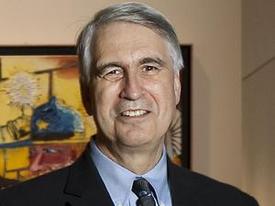More turnover at the top of a yet another Texas museum: Earlier this week, Ned Rifkin resigned as director of the Blanton Museum at the University of Texas at Austin, less than two years after he arrived. The university’s provost, Steven W. Leslie, immediately promoted the deputy director for external affairs and operations, Simone Wicha, to the top slot.
 Rifkin stays on at the university to do research and teach, but his quick replacement probably reflects unhappiness with within the Blanton/university. The exact nature of Rifkin’s difficulties — or disagreements with the powers that be — are unclear, but his departure has been rumored for weeks.
Rifkin stays on at the university to do research and teach, but his quick replacement probably reflects unhappiness with within the Blanton/university. The exact nature of Rifkin’s difficulties — or disagreements with the powers that be — are unclear, but his departure has been rumored for weeks.
Rifkin came to the Blanton from the post of Undersecretary for Art at the Smithsonian. Before that, at the job he held until 2001, he was director of the Menil Collection in Houston, where he faced a board divided by his leadership and performance, a situation recounted here on 29-95.com. Rifkin also once headed both the High Museum and the Hirshhorn Museum.
In the press release announcing Rifkin’s resignation from the Blanton, Leslie said the university appreciated his knowledge, and noted that Rifkin had improved student involvement with the museum, but not much else.
It was Rifkin, who reorganized the Blanton’s staff last April, who had promoted Wicha from director of development to deputy director.
Like the Blanton — Austin’s largest art museum — both Houston’s biggest, the Museum of Fine Arts, and Dallas’s, the Dallas Museum of Art, are experiencing leadership change. The MFA’s beloved director, Peter C. Marzio, died last December, and Bonnie Pittman, the DMA’s much-loved director, recently announced that she would step down because of health reasons.
Photo Credit: Courtesy of Austin360.com


 In late January, the BMA put out an open call for applications from artists who would agree to travel to 15 countries, including China, Ecuador, Egypt, Ghana, India, Kosovo, Lebanon, Nepal, Nigeria, Pakistan, Kenya, Sri Lanka, Turkey, and Venezuela, and work with communities in each place, collaborating on works of art that will address social issues, like women’s empowerment, health, the environment, civic engagement, education, etc., on either a local or global level.
In late January, the BMA put out an open call for applications from artists who would agree to travel to 15 countries, including China, Ecuador, Egypt, Ghana, India, Kosovo, Lebanon, Nepal, Nigeria, Pakistan, Kenya, Sri Lanka, Turkey, and Venezuela, and work with communities in each place, collaborating on works of art that will address social issues, like women’s empowerment, health, the environment, civic engagement, education, etc., on either a local or global level. 
 Last summer, nine Smithsonian Institution museums (including the Hirshhorn and the Freer-Sackler) cooperated in a game called
Last summer, nine Smithsonian Institution museums (including the Hirshhorn and the Freer-Sackler) cooperated in a game called 
